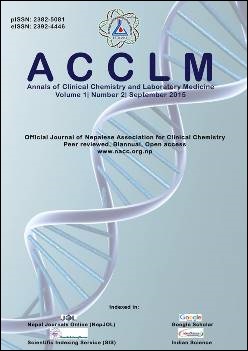Serum CA 19-9 Levels in Benign and Malignant Diseases Associated with the Gastrointestinal Tract
DOI:
https://doi.org/10.3126/acclm.v1i2.13546Keywords:
cancer marker, ca 19-9, GITAbstract
BACKGROUND: The diagnostic utility of CA 19-9 has been thoroughly evaluated and revised more than once over the past years in the context of pathological conditions related to the gastrointestinal tract. Our study was conducted to evaluate the diagnostic usage of CA 19-9 levels in the serum of patients affected with various disorders of the gastrointestinal tract, and to assess the diagnostic values in terms of severity and organ system involved in the context of clinical disorders requiring surgical interventions.
METHODS: A total of 70 patients admitted to various surgical units and the critical care units were randomly selected and the sera analyzed for levels of CA 19-9. Mean values were compared using independent t-tests and ANOVA, and cut-offs were estimated using ROC Curves.
RESULTS: CA 19-9 levels in the serum were found to be elevated in 57%, 50%, 100%, 81% and 63% of patients with Stomach / Upper GI, Liver / Gall Bladder, Pancreas, Colorectal and Lungs/Pleural pathologies respectively, with the normal cut-off values at 35 U/ml. In general, mean values of CA 19-9 in the serum were higher in patients with neoplasms (75.63±34.3 U/ml) compared to patients with inflammatory conditions (44.5±20.5 U/ml), (p<0.001). Similarly, mean values of CA 19-9 were higher in patients with malignant neoplasms compared to benign lesions (56.06±24.5 U/ml, compared to 88.39±34.2 U/ml, p = 0.003). Patients with pancreatic pathologies had the highest mean values of CA 19-9 in their serum 94.43±29.28 U/ml) compared to patients with other organ system pathologies (p< 0.001). When assessed separately, patients with malignant conditions of the pancreas had a higher mean value of serum CA 19-9 compared to patients with non-malignant and inflammatory conditions of the pancreas 121.0±16.7 U/ml compared to 74.5±17.86 U/ml, p<0.001). Mean levels of CA 19-9 were also higher in patients with surgically inoperable stages of malignant cancers of the pancreas in comparison to patients who had a surgically resectable mass in the pancreas (99.36±33.51 compared to 65.91±30.11 U/ml, p = 0.02). Finally, in order to establish a cut-off value for achieving maximal sensitivity and specificity to diagnose malignant conditions of the pancreas, the cut-offs were set at 92 U/ml achieving 100% sensitivity and 90% specificity.
CONCLUSIONS: The serum levels of CA 19-9 are practically elevated in all conditions associated with the Gastrointestinal System, and thus, at current cut-off values, this marker is at best, non-specific. Higher values, however, are typically associated with pancreatic conditions, both benign and malignant. Thus, with a higher cut-off value, CA 19-9 serves better as a specific marker for the diagnosis of clinical conditions of the pancreas, at preferably above 90 U/ml.
Downloads
Downloads
Published
How to Cite
Issue
Section
License
Authors who publish with this journal agree to the following terms:
- The author transfers copyright to the Nepalese Association for Clinical Chemistry.
- The journal publishes the work under a Creative Commons Attribution License that allows others to share the work with an acknowledgement of the work's authorship and initial publication in this journal and under the same share-alike license used here.
- Authors are able to enter into separate, additional contractual arrangements for the non-exclusive distribution of the journal's published version of the work (e.g., post it to an institutional repository or publish it in a book), with an acknowledgement of its initial publication in this journal.
- Authors are permitted and encouraged to post their work online (e.g., in institutional repositories or on their website) prior to and during the submission process, as it can lead to productive exchanges, as well as earlier and greater citation of published work (See The Effect of Open Access).




